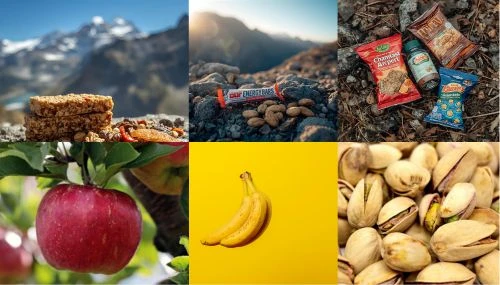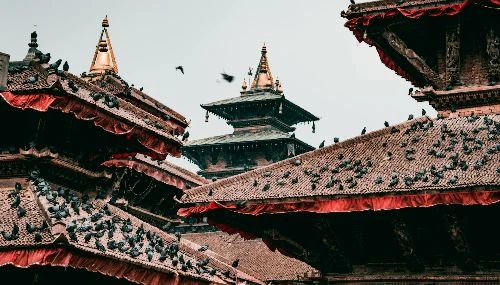Nepali Dal Bhat is a taste of Nepal. It is a fusion of steamed rice, lentils, a variety of curries and pickles, topped with ghee, and served with curd for dessert and salads of radish and cucumber as well as Papadam as a side snack.
Dal Bhat is an explosion of textures and tastes, unlike anything you've had before. It's no wonder Nepali people have Dal Bhat twice a day, typically mid-morning and early evening.
And if you order Dal Bhat in any place in Nepal, whether during your lowland Chitwan visit or high-altitude Everest region, you will get unlimited refills at no additional cost.
Here’s everything you must know about this finger-licking meal.
Ingredients and Components of Dal Bhat
A comfort food for many, Dal Bhat or Dal Bhat Tarkari is a combination of various makings. The following are the main ingredients that make a delicious and satisfying Dal Bhat.
Rice
In Nepal, they use steamed white rice, called "Bhat" in Nepali, as the main part of the meal. Typically, fragrant basmati rice, renowned for its aroma, or other varieties of long-grain rice is commonly used in Nepali cuisine for preparing “Dal Bhat.”
Lentil
Lentil soup is called Dal in Nepali. The most common lentils used in Nepali Dal Bhat are yellow, red, or black lentils (masoor dal, toor dal, or Maas dal respectively). Dal is prepared with onion, garlic, ginger, chili, tomatoes, along with lentils or beans.
It's always seasoned with herbs and spices like coriander, garam masala, cumin, and turmeric. In addition, oil or ghee is used for tempering spices and enhancing flavor.
Curries
Curries, known as Tarkari in Nepali, are what make the meal delicious. These curries include veg options for vegetarians, such as paneer, mushroom, potatoes, cauliflower, spinach, and other seasonal vegetables. For meat lovers, there are options like chicken, mutton, fish, buff, pork, and eggs.
These curries are loaded with a variety of spices with different flavors and aromatics. For vegetable curries, common spices include cumin, coriander, turmeric, fenugreek seeds, mustard seeds, and dried red chilies.
Spices like cinnamon, cloves, cardamom, bay leaves, and black pepper are also used. These mixed spices are also known as “Garam Masala or Meat Masala.”
Pickles
Nepali pickles, known as achar are to die for. These pickles will seriously make you eat 2 plates of dal bhat.
Back in the day, achar was a method used to keep vegetables and fruits fresh without refrigeration. Nowadays, you can easily find canned pickles in stores, or you can make fresh ones at home.
There are countless varieties of achar, each with its own flavor. Whether you like it spicy, sour, or tangy, there's definitely an achar out there for everyone.
Nepali pickles are typically made with vegetables and fruits like mangoes, Lapsi (Nepali hog plum), cucumbers, radishes, and even leafy greens like Gundruk (fermented greens).
These fruits and vegetables are seasoned and marinated with chilies, mustard oil, sometimes vinegar or lemon juice, and a variety of other aromatics like cumin, coriander, turmeric, and fenugreek. Not to mention, Nepali pickles are addictive.
Ghee
A hot Ghee on top of Dal Bhat takes the whole dish to another level. In Nepal, you get served homemade ghee or market-bought ghee.
Homemade ghee is made from scratch using butter churned from local milk in villages that tastes much better than the commercially produced ghee. Canned ghee’s taste might be slightly milder compared to homemade ghee.
Regardless, ghee boosts the overall Dal Bhat experience and turns it into a luxury cuisine.
Curd
Curd, also known as yoghurt and Dahi in Nepali is a delicious dessert that's both refreshing and tasty. Dahi can have different textures based on how long it's been fermented, from slightly runny to thicker and spoonable. It's good for digestion and is thought to help with gut health when eaten with heavier foods like lentils and rice.
Salads
Fresh radishes, carrots, lemons, and cucumber slices are typically served as salads on dal bhat plates.
Caloric Content and Nutritional Information

A standard plate of Nepali Dal Bhat has 600 to 1,000 calories depending on the items served.
Dal Bhat can be a nutritious meal, depending on what you put in it and how much you eat. It's a great way to get carbs, protein, fiber, essential vitamins and minerals, and probiotics.
Note that the following table includes calories for 100g serving (each item), and not the caloric content for a plate of Dal Bhat:
Ingredient | Calories (per 100g serving) | Key Nutrients |
|---|---|---|
Steamed White Rice | 130 | Carbohydrates, Vitamin B6 |
Yellow Lentils (Masoor Dal) | 340 | Protein, Fiber, Iron, Folate |
Red Lentils (Toor Dal) | 358 | Protein, Fiber, Potassium, Magnesium |
Black Lentils (Maas Dal) | 307 | Protein, Fiber, Iron, Phosphorus |
Ghee | 900 | Fat |
Spices (small quantities) | (generally low) | It may contain trace amounts of various minerals |
Pickles | (generally low - moderate) | It may contain Vitamin C (depending on the fruit/vegetable) |
Curd (Dahi) | 60 | Protein, Calcium, Probiotics |
Non-Veg Curry | ||
Chicken | 240 | Protein, Vitamin B12, Iron |
Buff | 250 | Protein, Iron, Zinc |
Mutton | 242 | Protein, Iron, Vitamin B12 |
Fish | (generally low - moderate) | Protein, Omega-3 fatty acids (depends on the fish) |
Pork | 340 | Protein, Vitamin B12, Iron |
Eggs | 150 | Protein, Healthy Fats, Choline |
Veg Curry | ||
Paneer | 260 | Protein, Calcium |
Mixed Vegetables Curry | (varies) | Vitamins, Minerals, Fiber (depends on the vegetables) |
Salads | ||
Carrots | (varies) | Vitamin A, Fiber, Vitamin K |
Cucumber | (varies) | Vitamin K, Potassium, Water |
Radish | (varies) | Vitamin C, Fiber, Potassium |
Types of Dal Bhat
In Nepal, various ethnic groups have their own delicious versions of Dal Bhat. The common and much-preferred types of this dish are standard Dal Bhat and Thakali Dal Bhat.
Standard Dal Bhat
Standard Dal Bhat is the most commonly enjoyed and basic version of Dal Bhat found throughout Nepal, from the Everest Base Camp Trek to the Kanchenjunga Base Camp Trek.
It consists of steamed rice (bhat) served with lentil soup (dal), vegetable curry (tarkari), pickles (achar), and yogurt. It is served on a single plate, usually made of metal (steel or brass) or ceramic.
Thakali Dal Bhat
Thakali Dal Bhat originated from the Thakali people of the Mustang region in Nepal.
Unlike the standard Dal Bhat, it is loaded with a wider range of side dishes and flavors with up to six or seven small bowls of different curries, including both vegetable and meat options. You’ll also get various pickles, papads, salads, and yogurt.
The main difference you’ll find between standard and Thakali Dal Bhat is Thakali khana set is infused with some Himalayan spices like jimbu (a herb belonging to the onion family) and Timur (Szechuan pepper).
Thakali Dal Bhat is served on a big brass plate and bowls. For an authentic and delicious taste of Thakali Dal Bhat, the Upper Mustang Trek is the best choice.
Veg vs. Non-Veg Dal Bhat
Veg and Non-Veg Dal Bhat are equally preferred in Nepal. In most households, vegetarian Dal Bhat is prepared every day, while some households have non-vegetarian meals two or three times a week.
Veg dal bhat includes steamed white rice, yellow, red, or black lentils with curries such as cauliflower, potatoes, mushrooms, spinach, and other seasonal veggies with pickles, salads, and curd.
Likewise, Non-veg Dal Bhat includes the same as veg but it comes with meats and eggs. Dal Bhat with chicken curry, Mutton (Goat) curry, and fish curry is much preferred in Nepal.
How to Eat Dal Bhat?

There’s a traditional method as well as a modern method of eating Dal Bhat. Traditionally, while eating Dal Bhat, you sit on the floor, cross your legs, and eat with your right hand.
In villages, this method is still in practice. However, in cities, many people eat with their hands or a spoon but they prefer to have their meals on the table. A fork can also be used but a dinner knife would be an overkill.
While eating Dal Bhat, whether with your hands or a spoon, you first mix lentils with rice, add curry and pickles, and crush the papad on top of it if served with one, give it a little mix, and eat it.
It can be quite difficult to eat with your hands if it’s your first time. You have to make a cup with your right hand or in a simpler way, you can hold together your first bite, put it on the front palm, and push it with your thumb.
Eating with your hands gives you a better taste of the meal. Not to mention, it tastes better with hands than with spoons and forks. Ensure your hands are clean and sanitized, the Nepalese wash their hands with soap and water before enjoying their meal.
Where to find authentic Dal Bhat experiences in Nepal
You can find Dal Bhat in every corner of Nepal as it is the national dish. From local restaurants, homestays, and teahouses to five-star hotels and resorts, you can get Dal Bhat easily.
For the most authentic experience, you must go to family-run restaurants or homestays and lodges.
In Kathmandu, there are numerous restaurants often name starting with Thakali where you can savor authentic Dal Bhat with various options. Our Kathmandu Sightseeing Tour is perfect for you if you want to explore Kathmandu and try the most authentic Dal Bhat of Kathmandu.
Similarly, Pokhara has many homestays, restaurants, and hotels that provide Dal Bhat with its own Pokhara twists. If you want to experience the authentic Dal Bhat of Pokhara while enjoying the lakes, Paragliding, and Sightseeing, our Pokhara Tour package has got you covered.
Not to mention, Dal Bhat is one of the most consumed dishes in the trekking regions by locals, guides, porters, and tourists. As the trekking trails are mostly remote, food options are limited. As a result, Dal Bhat is what you have that keeps you fueling. No wonder it is said,” Dal Bhat Power, 24 Hour.”
If you’re trekking in the Everest region, chances are high you might have various food options besides Dal Bhat. The trails in the Everest region are quite developed, so you can enjoy pasta, pizza, and burgers along with traditional foods.
However, not all parts of the Everest region offer such variety. For instance, you can expect food options on the Luxury Everest Base Camp Trek, but not on the Everest Three High Pass Trek.
On the other hand, the Langtang region offers limited food options as it lies in the remote part of Nepal. Meals on the Langtang Valley Trek include simple Dal Bhat, dumplings, noodles, and Nepali flatbread.
Annapurna region is less remote than Langtang region. As a result, you’ll find various food options including fresh thakali Dal Bhat, standard Dal Bhat, bread, cereal, porridge, and spaghetti on your Annapurna Base Camp Trek.
.webp)

.webp)

